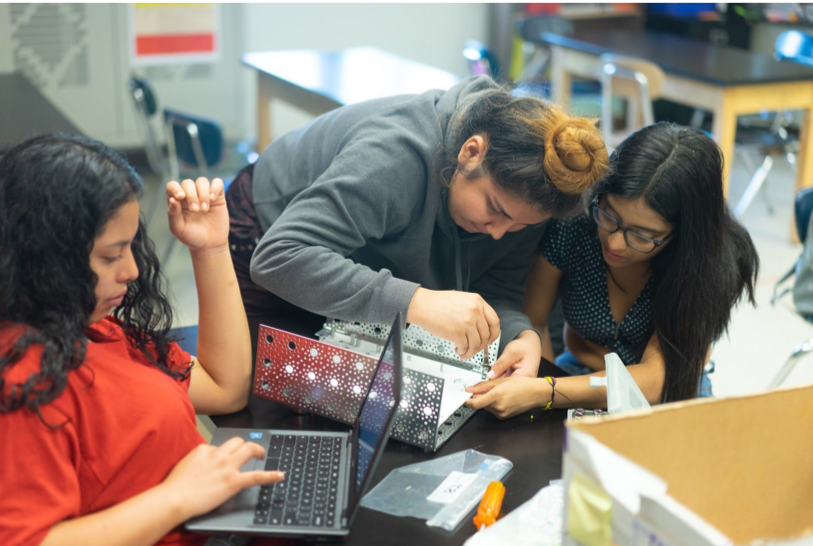When the Brooklyn School for Social Justice (BSSJ) teacher Rocio Montero began a robotics class this year, she knew it would be tough to secure costs and gain access to the computer science industry.
“They have so much potential but they just don’t have the opportunity. It’s crazy. The students in our communities just have little to no access,” says Montero.
Almost 30 Bushwick students joined together in-and-out of the classroom to build a Mars Rover replication —a motor vehicle made by NASA capable of exploring Mars’ surface. Montero shares that although building robots is possible for everybody, everyone can’t afford to. For these Bushwick students, it proved that all they needed was the opportunity.
“I discovered the gap in diversity in the technology field. I realized it’s happening to our young people of color. It made sense why I never went into it. I had a clear interest in robotics and engineering when I was younger. Why didn’t I have this opportunity? Why don’t my kids have this opportunity?” says Montero.

BSSJ had a previous robotics class that worked on LEGO EV3 robots. This new course was far more challenging this time around. NASA created a Mars Rover project manual for high school students. Unfortunately, the pieces and tools came with a heavy price tag.
Montero launched a GoFundMe campaign on January 13. She reached out to friends, family, local organizations, and people in the tech world. Initially, donations were coming in fast ranging from $5 to $100, but suddenly the donations stopped when they reached $1,500.
When Montero shared what the Mars Rover project would mean to these students and her aim to make computer science related careers more diverse, the donations began to pour in. There were so many donations that Montero had to turn off the Mars Rover Project GoFundMe account. In two months, the Bushwick students surpassed their $2,600 goal, earning a total of $3,100.
“I realized there was a gap that could be bridged within the tech world and public schools. There’s so much that can be tapped into,” says Montero.
It took a month for all of the Mars Rover parts to be delivered. After printing out manuals and making them understandable for her students, Montero divided them up into groups based on their strengths and weaknesses. The students worked in class, after class, and even during lunch to dedicate time to the Mars Rover.

Initially, the student-led club started with five students creating a community around robotics. Montero decided to incorporate the Mars Rover into her robotics classroom. Before she knew it, over 30 hands were taking part in building the robot. Montero noticed the collaborative effort the students put in changed their interactions with one another because they shared a common goal—building a Mars Rover.
Many of Montero’s students live in low-income areas with African, Latinx, and Caribbean heritage. For most of them, this was an opportunity they were grateful for opening new doors for college applications and future professions in engineering and technology.
A 18-year-old Bushwickian, Yoselin Escobar, found that although robotics wasn’t popular, it ended up being very interesting mainly because of their productive teamwork.
“I was surprised at how well I was able to interact with others because I didn’t know many of the students I worked with before this,” said Escobar.
For students with little to no experience and Montero discovering new things along the way, they needed help from the tech world. Patten Studio, a design agency, came in and taught them about electrical wiring and created printed circuit boards to aide their understanding of robotics. Hookooekoo, a ‘future’ company also extended design and engineering help.

Some of Montero’s students have applied to engineer programs at New York City College of Technology and asked her for recommendations following this project.
Another student, 17-year-old Monica Tenecela, says she is much more interested in computer science than she was before working on this project.
“I’m grateful for this experience because now, I’m trying to look into universities and colleges with programs in robotics,” says Tenecela.
According to CompTIA CEO Todd Thibodeaux, if properly implemented, diversity efforts could make the IT industry an additional $400 billion in revenue each year.
Montero is excited that there are initiatives being made to address this situation. Amazon approached BSSJ to launch its first computer science program through Amazon Future Engineer.
The next step for Montero is figuring out how to display the robot in a way where it could be handed down to students and generations to come.
Photo Courtesy of Rocio Montero.
For more news, sign up for Bushwick Daily’s newsletter.



